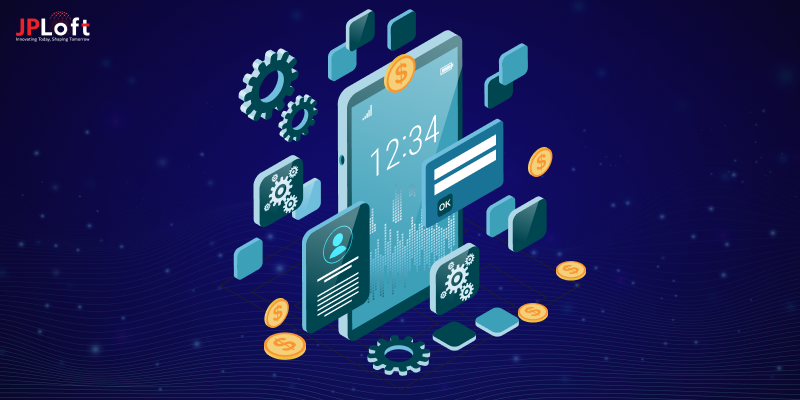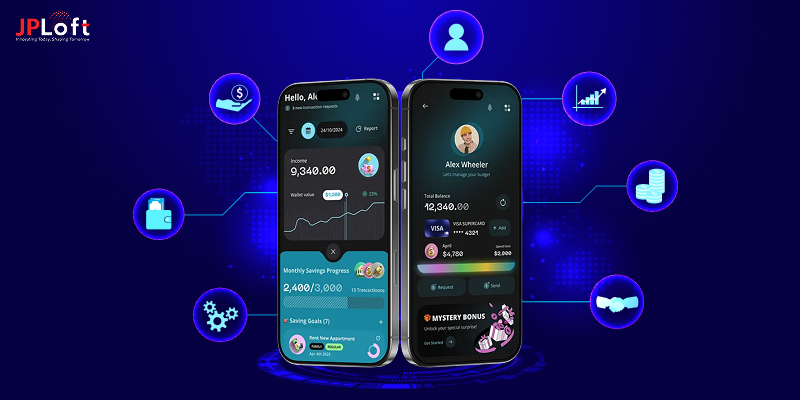At the forefront of finance's rapid evolution lies technology's impact, commonly referred to as FinTech (Financial Technology). Fintech apps explicitly designed to address financial requirements or services are the cornerstone of its growth, typically known as Fintech App Development Services. Fintech apps encompass an expansive spectrum of services spanning mobile banking and digital wallets to investment and peer-to-peer lending platforms. By harnessing cutting-edge technologies like blockchain, AI/ML/DL analytics, etc., they aim to streamline traditional financial processes while making services more user-friendly internationally. Fintech apps require an integrative team approach from experts across finance, software development, user experience design, security, and compliance - to craft user-friendly interfaces and adhere to all regulatory guidelines regarding sensitive financial transactions and data.
Fintech app development services involve multiple phases, from ideation and prototyping through development, testing, and deployment. Also there are various factors that contribute to the Fintech application development costs. Typically, this begins with in-depth market and user research to identify pain points and opportunities before developers focus on designing user experiences that deliver real-time tracking of data streams, tailored recommendations, and frictionless payments - creating seamless experiences through design.
Fintech Apps: What Should You Look for?
There are some key things you need to keep in mind before embarking on developing fintech apps:
Regulatory Compliance
Financial industries are tightly regulated to safeguard consumer well-being. Before creating any fintech app, you must conduct extensive research of any applicable regulatory requirements - depending on its nature or scope in different regions; compliance must be achieved regarding anti-money laundering (AML) legislation or data protection statutes; KYC obligations also need to be fulfilled for successful operation - failure could incur legal issues as well as irreparable reputational damage - to meet them successfully for the successful operation of your fintech app.
Security Measures
Financial data must always come first in terms of protection. Fintech applications frequently deal with personal and financial data that poses potential threats from cyber attackers; hence, solid encryption methods, secure authentication protocols, and regular audits in their development must be considered crucial elements to building user trust in financial apps - any breaches can have devastating repercussions for user trust in these applications.
User Experience (UX) Design
A key to designing an impactful fintech app lies within its UX. For maximum effectiveness, an effective UX should be user-focused, intuitive, and friendly for newcomers and experts alike without making them feel confused by complex interfaces or instructions that lead to disillusionment and eventually cause them to abandon an otherwise beneficial platform.
Scalability
Fintech applications that experience rapid user growth often need their architecture to accommodate additional loads without negatively affecting performance; any downtime could cost money and damage your reputation.
Integration with Financial Institutions
Fintech applications rely on seamless integrations with traditional financial institutions like banks, payment processors, and credit bureaus; building robust APIs capable of communicating securely is essential if these integrations are to remain functional over time and maintain them effectively as technologies shift.
Data Privacy
Fintech applications store vast quantities of personal and financial data. Therefore, these apps must implement an open and comprehensive privacy policy to describe how this data is collected, utilized, and secured - particularly considering regulations like the General Data Protection Regulation (GDPR) or California Consumer Privacy Act (CCPA),which could result in serious legal consequences should any breaches take place.
Accessibility
Financial services should be accessible to everyone, including people living with disabilities, by meeting accessibility standards in your fintech application and widening its user base while showing commitment to inclusivity.
Performance and Speed
Fintech applications should process transactions rapidly and respond immediately to user interactions in real-time transactions such as trading. Any delays could frustrate users or lead to financial losses in real-time transaction scenarios like trading.
Customers Support
Customer support systems are integral in effectively meeting user concerns and resolving issues efficiently, from chatbots and emails to phone services; users should have immediate access to assistance if experiencing difficulties.
Continuous Testing and Iteration
Test, Iterate, and Improve Continued Fintech app development doesn't end after its first version has been made public; ongoing user testing, feedback analysis, and iterative improvements must occur regularly to keep pace with user expectations, technological innovations, and shifting regulations.
Financial Literacy
Fintech apps often introduce users to unfamiliar financial tools and concepts. Therefore, for optimal user experiences and adoption rates of your application, it must offer clear explanations and resources to promote financial literacy - equipping users with knowledge increases adoption rates while creating positive experiences over time as they use your app more frequently.
Transparency
Building trust with user’s means communicating clearly about fees, transaction processes, and any risks related to an app's usage. Hiding or complicating costs could dissatisfy them or impact credibility negatively in an unfavorable light.
Backup and Recovery
For optimal protection in case of technical breakdowns or data breaches, adequate backup and recovery mechanisms are imperative to preserving user data while rapidly recovering applications in emergency scenarios and maintaining account functionality. In such circumstances, having enough backup storage means user accounts remain operational during this process.
Factors Affecting FinTech Application Development Costs
Below are vital aspects contributing to FinTech application development costs, showing why working with an app development firm is integral in meeting any challenges associated with building them.
Complexity and Features for FinTech App Development
The complexity and features of FinTech apps are one of the primary determinants of FinTech application development costs; more intricate parts or functionalities result in more extraordinary expenses; apps requiring AI chatbots, real-time data analytics, or blockchain integration need experienced developers, designers, and data scientists. A Fintech App Development Company with capable teams is best equipped to deal with such challenges efficiently. Still, intricate features also contribute to increased costs.
Design and User Experience (UX)
FinTech app development companies employ UX/UI experts with vast expertise in user engagement designs that influence adoption/retention rates from real-world app stores. Hence, customers have an effortless user experience when dealing with financial matters. Customers increasingly expect seamless interactions when engaging in economic issues via Fintech apps - user engagement designs have an enormous effect on adoption/retention rates from app stores!
Security and Compliance
Security and Compliance in FinTech, especially in FinTech application development costs, cannot be taken for granted when sensitive financial data are at stake. Fintech App Development Companies invest heavily in robust security measures like encryption, secure authentication, and audits - yet their implementation adds expenses to development expenses.
The decision of Technology Slate
One of the critical determinants in FinTech application development costs is choosing an appropriate technology stack. Emerging technologies, like blockchain and machine learning, can significantly expand app functionality while necessitating special skills from developers. An app development company with in-depth knowledge about cutting-edge tools and frameworks is better equipped to make informed decisions when selecting these advanced tools; however, due to their relative complexity, they typically incur higher development fees, necessitating trained specialists.
Platform Compatibility
FinTech apps must be compatible with various operating systems and devices - smartphones, tablets, and web browsers - to remain viable across multiple working environments and devices like smartphones, tablets, and browsers. While developing separate versions for different platforms can add substantial FinTech application development costs to development time and expenses, using technologies to facilitate code-sharing across platforms could significantly shorten development time and reduce costs substantially faster - working with an experienced Fintech App Development Company may expedite development by sharing code across platforms while decreasing development expenses significantly.
Integration with Third-party Services
FinTech apps often utilize third-party services like payment gateways, identity verification providers, and data aggregators to enhance app functionality while incurring increased costs. Integration between various services may improve functionality while increasing complexity and affecting prices; the expertise of Fintech App Development Companies in integrating multiple services may produce cost-efficient solutions, but licensing expenses must always be factored into integration efforts.
Testing and Quality Assurance
Testing is crucial to detect bugs, vulnerabilities, and usability issues with an app, including structural or functional flaws or security threats that compromise its secure functioning and seamless functioning - An experienced Fintech App Development Company employs testing professionals who thoroughly check it under various scenarios while considering costs when creating their budgets.
Project Management
Good project management is integral to any successful app development effort. Fintech App Development Companies employ professional project managers as part of their management teams to oversee development lifecycle phases, ensure on-time progress, and allocate resources efficiently. While project management helps prevent delays or cost overruns, it increases overall expenses.
Regulatory Challenges
Navigating the FinTech regulatory environment presents its own set of unique obstacles. Staying compliant with financial regulations and licensing can be time-consuming and expensive; consulting firms experienced in Fintech are an ideal source for providing insights on adherence while accounting for any legal or consulting costs that might be necessary, including any fees for legal advice that might be necessary.
FinTech Apps: Types and Cost Estimation
This article covers various FinTech apps and their associated FinTech application development costs, providing valuable insight.
Understanding FinTech Apps
FinTech apps encompass an expansive spectrum of financial technology applications designed to reshape financial services through technology, using cutting-edge platforms like artificial intelligence, blockchain, and mobile phones for innovative financial service offerings. FinTech can generally be divided into one of four groups:
- Payment and Mobile Wallet Apps: These apps make transactions quick, safe, and effortless by offering users safe ways of paying bills online, sending fund transfers between accounts, or splitting bills digitally. They usually integrate with various payment methods - from credit/debit cards, bank accounts, or digital wallets like Apple Pay/Google Pay - offering seamless convenience when paying or transferring funds between accounts or bills digitally.
- Investment and Trading Apps: Investment apps offer users easy access to investment opportunities, making purchasing and selling stocks, cryptocurrency, or other assets straightforward. These applications typically provide real-time market data, research tools, and portfolio tracking features for added ease.
- Peer-to-Peer Lending Apps: Peer-to-Peer Lending Apps are online platforms that connect borrowers directly with individual lenders rather than traditional financial institutions or banks for personal and business loans at competitive interest rates, often at times when traditional institutions don't exist. These platforms facilitate loans when traditional institutions don't exist as an option.
- Personal Finance Management Apps: Personal financial management apps provide practical budgeting, expense tracking, and goal-setting tools to help users effectively manage their finances. They give insight into spending patterns while offering strategies to save money.
- Digital and Neobanks: App-based digital banks or Non Banks offer banking services without physical branches, including checking/saving accounts, loans, and digital debit cards with user-friendly interfaces and efficient services.
- InsurTech Apps: InsurTech apps simplify purchasing and administering insurance policies by providing personalized policy recommendations, claims processing services, and renewal renewals, all via digital platforms.
- Cryptocurrency Wallets and Exchanges: With the rising popularity of cryptocurrencies, numerous apps that facilitate its storage, trading, and management have appeared, providing secure solutions for storage, trading, and price tracking conversion between digital assets and secure wallet options to safeguard them safely.
Cost Estimation for FinTech App Development
The costs of developing a FinTech app may depend on multiple variables; therefore, budget estimates must reflect them accurately. Understanding key indicators plays an integral part in building such apps accurately:
- App Features and Complexity: An application's complexity and features outsize its development costs; simple payment apps could cost less than complex investment platforms with real-time analytics and trading features.
- Platform and Devices: Optimizing development efforts across platforms such as iOS and Android and devices (smartphones/tablets) significantly increases development time and costs; cross-platform development tools could help offset some of this expense.
- Integrating With Third-Party Services: FinTech apps often integrate with third-party payment gateways, banking APIs, and financial data providers - though complex integration may increase costs unexpectedly and lead to additional expenses compared to anticipated.
- App Maintenance and Updates: App maintenance costs have become one of the primary ongoing expenses associated with owning an app, accounting for more than 70% of ownership-related expenditures.
- Development Team: Costs associated with hiring a development team depend heavily upon its skill set and location; employing more seasoned developers may increase initial investments but provide you with better outcomes overall.
- Regulatory Considerations: Depending on your app's functionality and target market, complying with specific financial regulations might be required, which adds complexity and cost if regulatory bodies impose penalties against it.
Monetization Process of Fintech App Development
Financial Technology (Fintech) has rapidly progressed to offer innovative financial management solutions and apps. Fintech apps have quickly become indispensable tools for individuals and businesses, providing convenience, efficiency, and novel methods of handling transactions. But, their development requires technical skills and an in-depth monetization strategy. In this article, we'll delve deeper into this process to identify critical points developers/entrepreneurs should bear in mind to establish sustainable revenue streams from fintech application development projects.
Choosing the Right Monetization Model
Before embarking on app development, it's essential to identify an ideal monetization model. Fintech applications often utilize various monetization schemes like these:
- Freemium apps: Offering users free access to core app features while offering upgraded ones at a subscription cost.
- Subscriptions: Charging users an ongoing recurring subscription fee to use its services - often divided by tiered levels of functionality or tiered subscription plans.
- Transaction Fees: Charging transaction-specific percentages or fixed amounts in fees on every financial transaction conducted via the app.
- Advertising: Displaying targeted advertisements that generate revenue for advertisers by being shown directly to users.
- White-Labeling: Leasing an app out for other businesses so they may rebrand and customize it for their customer base.
Establish Your Target Audience and Needs
Careful consideration must be given when targeting users within your desired demographic for successful monetization. Different user segments place other importance on additional features; individual consumers might place greater importance on budgeting tools, while businesses might prefer advanced payment processing capabilities, so tailoring offerings within your app to these individual user segments' requirements could influence which monetization model you ultimately utilize.
Developing Value-Added Features
Fintech apps should offer appealing, value-added features to entice subscribers and users into subscribing for premium versions or subscriptions - such as advanced data analytics, personalized financial recommendations, or exclusive access to financial advisors - to differentiate free offerings from paid offerings and ensure user loyalty.
Ensuring Security and Compliance
Fintech apps work with sensitive financial data, making security and compliance integral components. Users will more readily trust an app that protects its confidentiality and integrity by employing robust encryption techniques, multi-factor authentication systems, and meeting industry regulations such as GDPR or PCI DSS.
Experience Matters
User experience plays an essential part in the monetization process. An app with complicated processes won't win customers over. However, providing users with an enjoyable financial management interface could increase engagement, leading to higher conversion rates for premium services.
Pricing Strategy
Reaching an ideal pricing strategy requires striking a balance. Overly high pricing could scare off potential customers. At the same time, too low could diminish user perception of the value of your app. A/B testing provides invaluable feedback by measuring user responses at various price points.
Marketing and User Acquisition
Developing an incredible app isn't enough; people must also know about it! Effective marketing strategies - content marketing, social media campaigns, and partnerships with financial institutions - can significantly accelerate user acquisition. Users will likely adopt it even faster by emphasizing its unique value proposition in today's highly competitive markets.
Monitoring and Iteration
Once launched, user engagement monitoring, conversion rate evaluation, and feedback analysis are fundamental to assessing what's working well and where further adjustments may be required. Regular iterative updates based on this user feedback could boost value proposition and app monetization potential.
Customer Support
Delivering exceptional customer support helps build trust among users and encourages them to purchase premium features. Prompt responses to user issues or inquiries can create positive user reviews and referrals, further expanding an app's user base and revenue potential.
Diversifying Revenue Streams
Diversifying your revenue streams can open up additional sources of profit. For instance, an app that offers personal financial management could partner with financial institutions to earn referral fees when new accounts open through it.
Considerations of Geographic
Factors Monetization strategies may need to be customized depending on where they're implemented due to differences in economic conditions and purchasing power in different regions; accordingly, prices might appear more affordable or expensive in other areas.
Adopt Fintech Trends
Fintech is constantly shifting, so staying up-to-date with emerging market trends through app features and monetization strategies that remain current is integral for staying relevant and maintaining competitive advantage.
Conclusion
Businesses seeking to harness FinTech application development must understand its cost dynamics to harness its transformative power. FinTech Application development costs depend on many variables affecting its worth, such as complexity, features, platform, design, security, and integration into financial systems - each involving overall costs. As FinTech rapidly evolves into new fields of financial service innovation, demand remains vital for innovative apps explicitly tailored to enhance these services. At this stage of your journey, the next step should be hire FinTech Developers. Working alongside experienced FinTech specialists ensures the creation of robust applications tailored to user expectations that comply with compliance regulations while meeting unique financial sector demands. Hiring FinTech developers might seem costly at first glance; however, this should be seen more as an investment than an expense. A well-designed and functional FinTech app could bring substantial returns by drawing users in, streamlining processes efficiently, and giving your firm a competitive advantage in the marketplace. Partnering with experienced FinTech developers often results in faster development cycles with reduced post-launch issues - thus decreasing overall total costs over time.












Share this blog